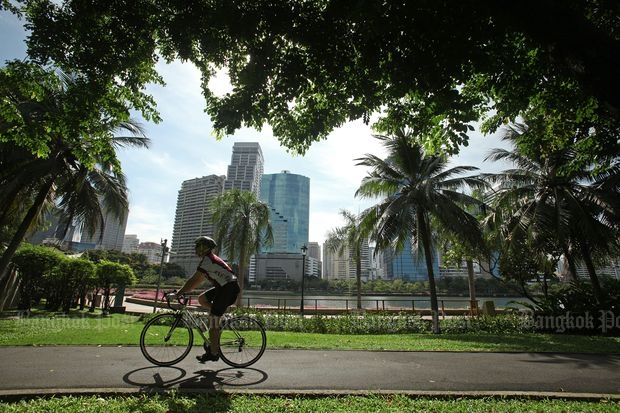
There are ambitious development projects underway in Bangkok but they are not retail, commercial nor residential in nature -- instead, they are open, green public spaces.
A similar picture is seen across Asia as governments and city dwellers take a greater interest in the development and enhancement of the region's public spaces, according to international property services firm JLL
Earlier this year, the first phase of the Benjakitti Park expansion opened, adding more than 60 rai of new green space on land formerly occupied by Thai Tobacco Monopoly. Additional expansion phases should bring another 360 rai of park land and public space over the next 1-2 years.
On tap for 2017 is Centennial Park, being built by Chulalongkorn University to celebrate its 100-year anniversary. When complete, central Bangkok will have 28 rai of new green space available for public use connecting the Siam Square area with Rama IV Road to the south.
Also in the pipeline for next year is Phatumwananuruk Public Park, a 40-rai park being built behind CentralWorld, adjacent to Khlong Saen Saeb.
According to Andrew Gulbrandson, head of research and consulting at JLL in Thailand, ongoing and future planned green space initiatives in Bangkok will undoubtedly have a positive impact on the liveability of the city. "They will create a healthier, more attractive environment for residents, visitors, and the business community alike," he says.
In Wuhan, China, the Donghu Greenway is under construction. It involves the rejuvenation of thirty-three square kilometers of the Donghu Lake area, the largest urban lake in China. Once it's open to the public at the end of 2016, it will be car-free, have open parks, and include spaces for culture and education.
Chua Yang Liang, JLL's head of research for Southeast Asia and Singapore notes: "In emerging Asian cities, the policies can definitely have an impact in setting aside areas for public space. Now these cities are beginning to see the value of having more planned or organized integrated green park spaces. They see it as part of their urban solution," says Mr Chua.
Surabaya in Indonesia, for example, is one city where rapid growth has led to increasing land prices and a soaring property market. With space maximized inside homes, residents rely on public spaces. Among them is the Bungkul Park, a 15,000 square meter space that has an amphitheatre, fountains, jogging paths and a children's playground, and also provides free WiFi.
Older cities such as Manila and Mumbai face different challenges. Many have already been overdeveloped and forced to retrofit more public spaces into their designs. "That's why it's very hard for policies to have an impact, especially in older cities," says Mr Chua.
It's far, however, from impossible. Seoul, for example, transformed a congested highway into a landscaped walkway in the heart of the city which is now visited by more than 60,000 people a day.
Asia also has many privately owned public spaces (POPS), which are typically owned by developers but are accessible to the general population, including malls and commercial plazas.
Investing for future
As urbanisation leads to denser cities and higher demand for available land, the pressure is on to create and maintain public spaces.
Some of Asia's biggest cities are taking a communal approach to generate solutions by crowdsourcing ideas. For example, Singapore's Urban Redevelopment Authority runs an annual Ideas for Public Spaces competition and Malaysia has created an annual arts and culture event known as Urbanscapes that showcases Kuala Lumpur's public spaces and creative communities.
And creating such spaces, particularly green spaces, are just the start. As a long-term commitment they require regular investment to keep them fit for purpose. "The challenges are in maintaining it and ensuring that the public spaces are kept clean," says Mr Chua.
For cities and the people who live within them, the benefits can outweigh the costs, improving the immediate environment, boosting the quality of life and helping to create a thriving and prosperous society.